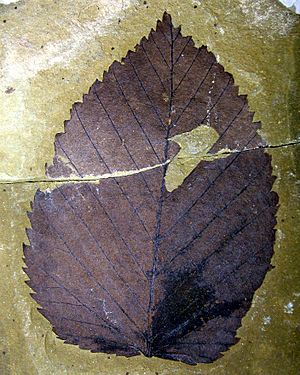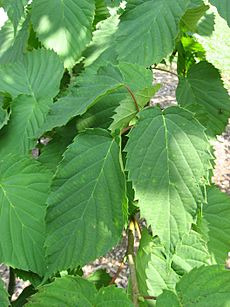Tsukada davidiifolia facts for kids
Quick facts for kids Tsukada davidiifolia |
|
|---|---|
 |
|
| T. davidiifolia fossil leaf | |
| Scientific classification | |
| Genus: |
Tsukada
|
| Species: |
davidiifolia
|
Tsukada is an extinct type of flowering plant. It belonged to the family Nyssaceae. This plant was a relative of the modern "dove-tree," which is known as Davidia involucrata. The only known species in this group is Tsukada davidiifolia. Scientists have found fossil leaves of Tsukada in rocks from the early Eocene period. These fossils were discovered in northern Washington state, United States, and in British Columbia, Canada.
Discovering Tsukada
Scientists have found Tsukada leaf fossils in two main places in Western North America. One place is the Klondike Mountain Formation near Republic, Washington. The fossils found here are about 49 million years old. The other place is called the One Mile Creek area, near Princeton, British Columbia.
How Tsukada Got Its Name
Scientists named Tsukada after studying several fossil leaves. The main leaf used for the description is called the holotype, UW 71095. Other leaves, called paratypes, were also used. These fossils were part of the paleobotanical collections at the Burke Museum.
Jack A. Wolfe from the University of California and Wesley C. Wehr from the Burke Museum studied these fossils. They found them in the Republic, Washington, area in the early 1980s. In 1987, they wrote the official description for the new plant group and species. This description was published in a book about plant fossils from North Eastern Washington.
The name Tsukada was chosen to honor Matsuo Tsukada. He was a palynologist (a scientist who studies pollen) at the University of Washington. He did important work on ancient environments and how plants spread. The second part of the name, davidiifolia, was not explained by the scientists.
Scientists compared the leaf veins of Tsukada to those of the "dove tree," Davidia involucrata. They noticed that the veins branched differently. Tsukada also had looped side veins, while the dove tree had straight, stronger ones. The glands on the teeth of Tsukada leaves were also shorter and less clear.
One interesting fossil leaf from the One Mile Creek area shows a distinct mark from an ancient insect. It looks like an oval-shaped bump on the main vein of the leaf. This bump, called a gall, had several small rooms inside. It also had round holes where insects likely exited. These galls are similar to those made by Cecidomyiidae gall midges. This suggests that a type of gall midge caused the bump on the Tsukada leaf. No such galls have been found on modern dove tree leaves.
What Tsukada Leaves Looked Like
The leaves of Tsukada had a simple structure with veins branching out like a feather. The main side veins reached all the way to the edge of the leaf. There were no smaller veins connecting the major side veins. The next set of smaller veins branched off the side veins at sharp angles. These smaller veins sometimes branched again. The very tiny veins formed a net-like pattern, creating generally four-sided areas.
The edges of the leaves had teeth, with at least one tooth for each main side vein that reached the edge. A side vein entered each tooth near its middle. The tips of the teeth had a small, unclear glandular area.
Each leaf had six pairs of main side veins. These veins branched off the central vein at about a 45-degree angle. Each vein curved widely from the central vein towards the leaf edge. Most of them forked once from their lower side. The veins that forked either angled out to the edge or curved just before reaching it. The lowest pair of side veins was not as strong. They angled off the central vein at an 80-degree angle. Each of these had seven smaller veins branching off its lower side. The leaf stalk, called the petiole, was slightly heart-shaped. It was surrounded on each side by the leaf blade.


